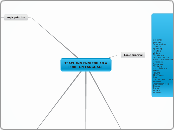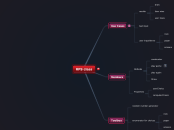Speech Development
Child directed speech
Pragmatic development
Hallidays functions
Imaginative
Language is used to create an imaginary
enviroment. May accompany play
Heuristic
Language is used to learn and explore
the enviroment
Representational
Language is used to convey facts and information
Personal
Language is used to express ideas, opinions
and individual identity
Interactional
Language is used to develop
social relationships and ease
the process of interaction (phatic talk)
Regulatory
Language is used to influence
others' behaviour
Instrumental
Language is used to fulfil
a particular need
Negatives
Ursula Bellugi
STAGE THREE
there is more variety in tense. 'not' is used after
main verb. Improved a lot but still has some issues.
E.G. 'this cant stick' or 'i not crying'
STAGE TWO
cant and dont start being used but
without variation of verb tense.
No is still used but appeared mid-sentence.
E.G. 'you cant dance' or 'he no bite you'
STAGE ONE
producaes affirmative sentences
with no added to the beginning or
the end.
E.G. 'no sit there' or 'not my bed'
Phonological development
6. Metathesis
sounds in a word are swapped round
'relevant' becomes 'revelant'
5. Assimilation
when sounds in a word are made to sound more
like neighbouring ones
'dog' becomes 'gog'
4. Reduplication
where a syllable in a word is repeated
'wee-wee' or 'night-night'
3.Substitution
substituting harder sounds with easier ones;
'r' becomes 'w'
'th' becomes ''d,n or f'
't' becomes 'd'
'p' becomes 'b'
2. Addition
breaking up consonant clusters by adding vowel to separated them;
'blue' becomes 'belu'
1. Deletion
simplifying pronunciation by deleting certain sounds;
the 't' being dropped in 'hat' or 'cat'
Asking questions
Inversion of auxilary and subject
Inversion of main verb and subject
Wh- questions
Rising intonation
Theories
LENNEBERG
CRITICAL PERIOD THEORY
The human brain is designed
to acquire language at a certain
time (first five years) and once this
period has passed normal language
development is no longer possible.
Genie - was locked up until the
age of 13 never learned to
speak fully.
BRUNER
SOCIAL INTERACTIONIST THEORY
Language is social. 'Children initially use
language to get what they want'.
Childrens language development is
enriched and accelerated due to quantity
and quality of social interactions with adults.
Clarke-Stewart
found that children whose mothers
talk more have larger vocabulary
PIAGET
COGNITIVE DEVELOPMENT
Language development goes
hand in hand with the development
of thinking and knowledge.
When seven year olds were
taught phrases like 'more than'
and 'less than' it did not help
then grasp these concepts.
The words are usually acquired
after the concepts have been grasped
CHOMPSKY
INNATE
babies born with innate knowledge
of the structure of language and speeds
up their learning of their native language
when they hear it.
Berko-Gleason
found children were able to
provide the plural of 'wug' the
name of an imaginary creature,
even though had never heard
the word before
SKINNER
IMITATING
Children learn to speak by imitating their parents
and being rewarded or punished according to the
accuracty of their utterances.
Childen eventually learn to
say 'went' instead of 'goed'.
This seems to be learned
through listening, imitating
and correction
Learning to read
Harris and Coltheart
Subtopic
THE DISCRIMINATION NET STAGE
where children are beginning to pay attention
to the orthography, but in a fragmentary way.
THE SIGHT VOCABULARY OR WHOLE WORD STAGE
where children recognise written words
as a whole and are not aware of their
internal orthographic strucutre
METHODS
Whole word schemes
based on recognising words as
a whole
Arguments against;
object to the often arbitary
choice of words, which are
not always closley related to
childrens experiences
Argumaents for;
system allows access to longer
and more meaningful sentences,
through frequently occuring words
and the use of some longer words
Phonic schemes
based on identifying the regular sound
letter relationship in a writing system.
Child should use this to decode or constuct words.
Arguments against;
A child will stuggle to blend
individual sounds into a word
and also point out that there are
severe restrictions on the vocabulary
Arguments for;
a child has a rationale for
'sounding out' new words
Stages of developing reading
Learning the conventions of punctuation and layout
Words go together to form sentences
words say the same thing every time
Realising that sound combine to make words
Realising letters make words
associating sounds and letters
Recongnising letters
Features borrowed from
the oral tradition
Epithet as Metaphor
Rhythmic language
Proverb or Aphorism
Repeated formulae
Assonance
balanced sentence
Repeated epithet
Alliteration
FRAME WORK FOR ANALYSING
CHILDRENS READING BOOKS
Features borrowed from the oral tradition of
story telling;
alliteration
repeated epithet
parallel sentence structures
rhythmic language
Influences from everyday speech;
face to face interactions
familiar scenarios
use of direct speech
informal register
repetition
Cohesion;
repetition
pronouns used after
referent well established
Grammar;
sentence types
sentence lengths
verb tense
use of active or passive voice
Lexis and semantics;
length of words
types of words
semantic field
concrete/abstract nouns
repetition
Graphology;
page layout
lineation
pictures
fonts/size of letters
Learning to write
Child Language Acquisition









